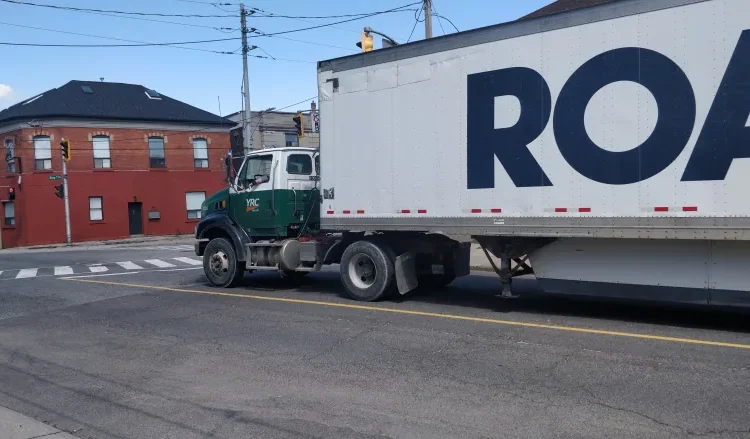The new truck routes are expected to come into force after an early July council meeting
Hamilton resident Chris Ritsma doesn’t live on an official truck route. But that doesn’t stop transport trucks — some with as many as many as eight axles, including the cab and a load two trailers long — from going down his street on a regular basis, he says.
He’s tried to report the trucks, which if not making local deliveries are supposed to be restricted to specific routes, but says police have told him photo and video evidence isn’t enough. They have to catch the offenders in the act. So far, he hasn’t seen any enforcement on his street.
That has Ritsma, who lives on the residential section of Barton Street West just east of Bay Street, wondering whether upcoming changes to the city’s truck route master plan will have their intended effect – to keep trucks off downtown streets.
The changes are among several in the works that many are hoping will make the city’s streets safer and feel more welcoming to pedestrians, cyclists and other road users.
Ritsma notes trucks doing local deliveries are allowed by the city’s Truck Route Master Plan, and will be going forward, so he wonders if it will be possible for police to determine which trucks should be there and which shouldn’t.
“The changes are only positive if they’re actually followed,” he told CBC Hamilton. “If there’s something I can do to support the police or enforcement… I just want to know how to do it.”
On April 13, Hamilton city councillors approved changes to the city’s truck routes that will reduce the number streets available to trucks, aimed at curbing trucks cutting through residential areas to get between the Highway 403 and Burlington Street.
It will limit trucks with five axles or more to major routes such as Burlington Street, the Lincoln Alexander Parkway, the Redhill Parkway and Highway 403. Those making deliveries downtown will still be permitted.
At a public works committee meeting in early April, the city’s director of transportation, planning and parking, Brian Hollingworth, said the transition will take time.
“[The change] won’t be immediate,” he said. “It’s not like [turning] on a switch. There’s a lot of work that needs to be done in terms of signage, mapping. We’ve got to update all the bylaws.”
Council directed staff to work with Hamilton Police to “review and develop an enhanced commercial vehicle enforcement strategy.”
Currently, truckers stopped while driving in an area that is not a truck route must explain the reason they are there to the officer making the stop, Const. Indy Bharaj said in an email to CBC. He did not respond to a question about whether police proactively conduct truck route enforcement.
The council decision also requires city staff to ensure the truck routes are “planned and designed with the appropriate roadway and pavement structure to support truck movement and reflect a Complete-Livable-Better Streets and Vision Zero approach.”
City staff are aiming to have the bylaw ready for approval for the July 6 public works committee meeting, says Steve Molloy, Manager of Transportation Planning. The signs would be phased in after that.
Ritsma says the coming changes make him hopeful that one day, Hamilton will get to a point where “a truck going through downtown will look odd. Now it’s so common people don’t even question it.”
‘You have to compromise’: trucking company VP
Steve Foxcroft is vice president of Hamilton-based Fluke Transportation, which sees many of its trucks driving through the city on a regular basis, from its Hamilton port location to destinations in Brantford and beyond.
He says his company will hold a drivers’ meeting as the changes become imminent, to make sure staff are informed of the new routes. He says the company’s drivers already follow GPS directions laid out for them by the company, so it will be a fairly straightforward process to change the directions to follow the new rules.
Where the challenge comes in for his company is in making sure drivers can get to their destinations southwest of the city and back before they are legally required to clock out, he says.
His company is located in Port Authority lands on Sherman Street, so at the end of the day, it’s more direct for drivers to get off Highway 403 at Main Street, travel east and cut north on Victoria Street. That route will no longer be allowed for trucks on the larger end.
“It’s an easy turn on Victoria. [The intersection is] made for it,” saying Foxcroft, noting he would have liked to see a compromise that kept this route viable. The new route will mean his trucks will have to take a longer route back to Sherman Avenue and Burlington Street, either along the Lincoln Alexander Parkway and the Redhill, or Highway 403 and the QEW.
Foxcroft contrasts that to the inner-city route in the opposite direction, which he says involves dangerous right turns onto King Street West from streets such as Queen and Dundurn.
A man in his thirties was sent to hospital in serious condition after the car he was in was hit by a turning truck at the King and Dundurn intersection on April 25. Police said at the time they believed the truck was turning left onto King Street.
Foxcroft says he understands the tension between the trucking industry and citizens trying to prevent truck traffic on their streets, and says that dealing with the outcome of a process like this is “part of the give-and-take of being a good citizen… It’s like a marriage, you have to compromise.”


